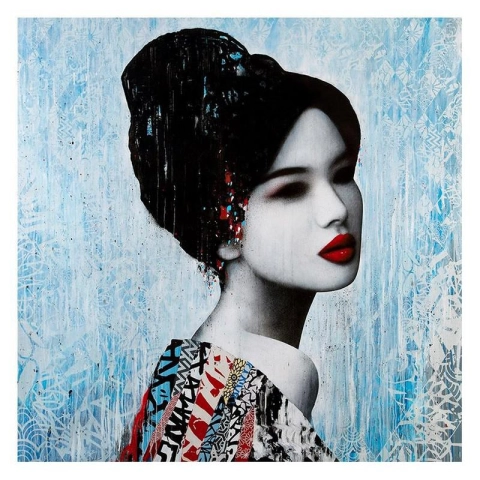Hand-painted painting reproductions - Movements - Pop art
Imagine owning a museum-worthy piece of art, created by the greatest artists in history and reproduced by passionate and experienced painters. At POD, we offer you the opportunity to make that dream a reality. We reproduce the works of art of your favorite painters from the Pop art art movement in the smallest details, so that you can enjoy them in your own home.
Our reproductions are made by experienced artists who use the best materials and techniques. We are committed to providing you with works of art of the highest quality, which will bring joy and inspiration to your family for generations to come.
Pop Art: The Celebration of Popular Culture and Bold Aesthetics
Pop Art emerged in the 1950s as a reaction against traditional fine art, embracing imagery from popular and mass culture. This movement revolutionized the art world by incorporating elements from advertising, comic books, and everyday consumer products. With its vibrant colors and bold compositions, Pop Art is perfect for those who appreciate art that challenges conventions and celebrates modern life.
Early Origins and Historical Context
Pop Art originated in Britain in the early 1950s before taking hold in the United States in the late 1950s and 1960s. Influenced by the post-war economic boom and the rise of consumer culture, Pop Art artists sought to blur the line between high art and commercial imagery.
The movement was a response to the seriousness of Abstract Expressionism, aiming instead to reflect the dynamic, media-driven world of the time. Key figures in the movement include Andy Warhol, Roy Lichtenstein, Richard Hamilton, and Claes Oldenburg, who redefined art through their bold, accessible works.
Artistic Development and Style
Pop Art is characterized by its vibrant colors, mass-production techniques, and use of everyday imagery. Artists borrowed from advertising, comic strips, and consumer goods to create art that was both familiar and provocative.
Key elements of Pop Art include:
-
Bright Colors and Bold Forms: Inspired by commercial printing and advertising aesthetics.
-
Use of Everyday Objects: Products like soup cans, soda bottles, and celebrities became central themes.
-
Mass Production and Repetition: Artists used silk-screening and other techniques to mimic industrial production.
-
Comic Book and Media Influence: Many works featured thick outlines and Ben-Day dots, referencing newspaper prints and comics.
Themes and Significance
Pop Art celebrated and critiqued consumer culture, reflecting the influence of mass media on contemporary society. The movement’s embrace of pop culture made art more accessible, bridging the gap between fine art and everyday life.
Key themes in Pop Art include:
-
Consumerism and Advertising: Pop Art highlighted the power of brands and media in shaping identity.
-
Fame and Celebrity Culture: Icons like Marilyn Monroe and Elvis Presley became central subjects.
-
Mass Production and Commercialism: Artists questioned the uniqueness of art by using industrial techniques.
-
Irony and Satire: Many works played with the contradictions of modern life, blurring the line between art and commercial design.
Achievements and Influence
Pop Art reshaped the art world, influencing movements such as Postmodernism and contemporary digital art. It challenged traditional notions of artistic value and paved the way for new forms of visual expression.
Notable Pop Artists include:
-
Andy Warhol: The most famous Pop artist, known for Campbell’s Soup Cans and Marilyn Diptych.
-
Roy Lichtenstein: Renowned for his comic book-inspired works, including Whaam! and Drowning Girl.
-
Richard Hamilton: A pioneer of British Pop Art, known for Just what is it that makes today’s homes so different, so appealing?.
-
Claes Oldenburg: Famous for large-scale sculptures of everyday objects like Giant Clothespin and Soft Hamburger.
Legacy
Pop Art continues to inspire contemporary artists, designers, and advertisers. Its bold aesthetics and cultural critiques remain relevant in the digital age, where media and consumerism play an even greater role in everyday life.
Today, Pop Art is celebrated in major museums like The Museum of Modern Art (MoMA) in New York and Tate Modern in London. The movement’s legacy lives on through street art, graphic design, and digital media, proving that art can be both playful and profound.
Where to Find Reproductions of Pop Art
For those looking to add the energy of Pop Art to their spaces, POD (Painting On Demand) offers high-quality reproductions of iconic works. From Warhol’s famous portraits to Lichtenstein’s comic-inspired pieces, these artworks bring the spirit of Pop Art into any collection, offering a timeless celebration of popular culture and artistic rebellion.








